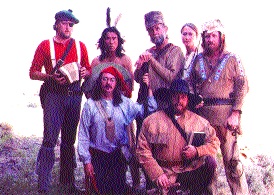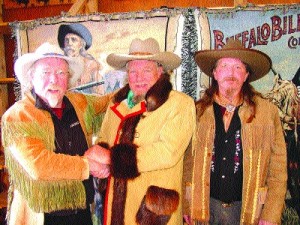By S. Clayton Moore
Meet Bobby Bridger and you’ll uncover a treasure trove of music, folklore, history and storytelling.
Bridger is the grandnephew of Jim Bridger, the legendary mountain man, hunter, guide and scout who headed into the unknown American west in the early 1800s and never looked back. Despite a fierce tenacity for life and a fondness for buckskin, that kinship represents more than just a famous name for Bridger, who has reinvented himself many times over as an author, folksinger and self-described “traveling troubadour.”
For more than 30 years, he has been translating the true history of western adventurers into a three-part epic, “A Ballad of the West,” which begins with his famous uncle as the protagonist of “Seekers of the Flame.” “Lakota” follows the story of Black Elk, the Native American holy man. “Pahaska,” from the Lakota Sioux word for “long hair,” follows the life of Buffalo Bill Cody and led Bridger to publish his new book, “Buffalo Bill and Sitting Bull: Inventing the Wild West,” through the University of Texas Press.
Bridger spoke at the Metropolitan Club on February 7. Among those there to hear him speak was Nick Meagher, on the board of directors of Arapahoe Bank and Trust in Centennial, who has his own show, “Nick’s Wild West Show,” in which Bridger has performed.
Meagher produces his shows mainly in California, performing at the annual film festival in Lone Pine, and other venues. Besides Bridger, his entertainers have included Eddie Three Eagles, a famed flute player.
On February 8, Bridger spoke at Buffalo Bill’s gravesite near Golden, Colo.
Bridger’s journey began early in his life with a fortunate trip into the Ozark Mountains of northwest Arkansas, shortly after he discovered the relationship to his famous uncle. At 18, he was invited to go into northern Arkansas on an expedition with a bona fide ballad collector who discovered Jimmy Driftwood, the famous “singing schoolteacher” (also known as James Morris). The schoolteacher wrote the classics “The Battle of New Orleans,” a hit for Jimmy Horton in 1960 and “The Tennessee Stud,” popularized by Johnny Cash, as lessons for his students.
In 1963, as Bridger and his mentor traveled through the isolated valleys, they discovered a few natives who still remembered what they termed “the old songs,” and it was a shock to find a strange influence among the mountain tunes.
“I heard this woman with a very pronounced southern Arkansas accent sing ‘The Jew’s Tale,’ from Chaucer’s ‘The Canterbury Tales,’ in Elizabethan English,” Bridger marvels. “It had been passed down from generation to generation in her family. That just set me on fire with the concept of balladry. I’m 58 years old and I haven’t gotten over it yet.”
Bridger started doing research, hoping to find a period ballad about his uncle and others who had set out into the wilderness.
“I thought it would be easy to find a ballad from that period,” Bridger said. “I thought the library shelves would be full of songs about these guys. Instead, what you find is Pecos Bill, Paul Bunyon and other characters who never existed.”Bridger found that while a few songs have survived from the fur trade period, most of the jigs, reels and songs of the day have been lost through time.
“Most of the men who came out to be mountain men didn’t come to write songs about it,” Bridger said.
As Bridger researched further, he decided that he would have to create his own history-telling songs. For example, “Seekers of the Fleece” reveals Jim Bridger’s role as a pivotal eyewitness to critical events in western history, after heading out with the Ashley Henry expedition of 1822, the first privately funded venture into the western frontier.
“Not only was he present at most of these events, but he was also a participant in them,” Bridger said. “As I started exploring his life through my writing, his eyewitness to these events became more important to me than my relationship with him.”

The late character actor Slim Pickens was the narrator in Bobby Bridger’s first recording. Here, Pickens studies the “Seekers of the Fleece” script while Timberjack Joe looks on.
Comrades and collaborators
Bridger steadily crafted his American chronicle while also perfecting his artistic talents. In addition to getting a degree in painting and sculpture from Northeast Louisiana University, he worked on his musical skills, eventually working with artists who would later help in recording his work. In addition to influential artists like Paul Simon and singer-songwriter Ramblin’ Jack Elliot, an early influence on artists like Bob Dylan, he was mentored by Fred Carter Jr., Simon’s guitar player who performs the 12-stringed solo on Simon & Garfunkel’s “Hazy Shade of Winter.”
“Fred took me under his wing and took me to Nashville. He taught me how to structure and record songs, and how to develop conventional song lyrics,” Bridger said.
Although Bridger worked in Nashville for a few years, releasing some singles and two albums for RCA, he eventually found that time was right to put “Seekers,” with a narrative flow in Homeric verse (imagine “Beowulf” or “The Odyssey” filtered through the daring and bloody history of the western frontier), on record.
Bridger’s use of Homeric couplets is a drastically different form than most modern poetry: “The year is 1822 / Jim Bridger lives in old St. Lou / He’s learning about the blacksmith trade / and firing him a dagger blade,” begins “Seekers.”
“When I first started doing the poetic narrative, people thought I was crazy,” Bridger laughs, “but we’ve been telling stories much longer than we’ve been sitting around in front of a glowing tube. I’ve always been interested in this form of storytelling because it allows me to eliminate time.”
He adds that the audience’s reception has more to do with the experience of oral tradition than with him or what he’s singing about.
In 1970, Bridger saw the three-minute pop song give way to more involved musical experiments like the Who’s “Tommy,” and Gordon Lightfoot’s “Canadian Railroad Trilogy.”
“The forms all through the industry started opening up just a little bit,” Bridger remembered.
By 1975, Bridger had assembled an incredible group of musicians in Denver to record “Seekers,” including actor Slim Pickens, who played bomber pilot “King Kong” in Stanley Kubrick’s “Doctor Strangelove.” In addition to Pickens as the narrator, the recording also features the Lost Gonzo Band, Timberjack Joe and Ramblin’ Jack Elliot.
Bridger’s work seems to attract artists not only of a high caliber but also with a particular mindset about the west. Outdoor productions of “Seekers” have featured actors like Tony-nominated Joe Sears (“Greater Tuna”) and Wes Studi (“Dances With Wolves” and the “Last of the Mohicans”). Robert Redford personally invited him to perform his one-man show at the Sundance Institute, and he has performed on PBS’ “Austin City Limits,” ABC’s “Good Morning America” and at benefit concerts featuring artists like Kris Kristofferson, Willie Nelson and Neil Young.
He also has collaborators close to home. Melissa Bridger, whom he married in 1989, at the Kerrville Folk Festival in Texas, where he has played every year since it was formed, has helped to edit his quarterly newsletter, “Hoka Hey!” and has played various parts in productions of “Seekers.”
In 1989, the couple welcomed their son, Gabe, named after a nickname given to Jim Bridger by fellow mountain man Jebediah Smith. He now performs on fiddle as the opening act for “A Ballad of the West,” and has become a traveling companion to his father.
Chasing Buffalo Bill
While the first and last parts of his trilogy were completed by 1973, Bridger spent years trying to nail down the idea of Buffalo Bill, to create a unique vision of a man about whom volumes have been written.

The 1988 cast of “A Ballad of the West” included future movie star Wes Studi. Standing, from left: Daryl Watson, Wes Studi, Steven Fromholz, Melissa Tatum and Bobby Bridger. Kneeling: Bill Gill and Joe Sears.
It wasn’t until he was continuing research on Black Elk that he ran into Buffalo Bill again. When Cody’s Wild West Show left England in 1887, the holy man of the Lakota Sioux and four of his band were left behind in Victorian England with only a handful of English words to their vocabulary.
“Two years later, when Buffalo Bill was reunited with Black Elk in Paris, Black Elk said, ‘Prohaska have strong heart.’ This holy man, who is now immersed in the 20th century as the author of what is now considered a Native American bible, ‘Black Elk Speaks,’ said Buffalo Bill had a good heart, when most modern Americans think Bill Cody did everything he could to destroy Native America,” Bridger explained. “This was a portal into a new interpretation.”
For inspiration, Bridger went back to the photos and posters of Buffalo Bill in the Wild West Show, marveling at Cody’s stature even among 700 riders. He started trying to write what hadn’t been written by pulling Cody, the man, away from the mythology of Buffalo Bill. In doing his research, Bridger found a dramatic relationship between Cody and the Lakota Sioux he met in melodrama as well as actual combat.
“The Wild West Show was not something that Bill Cody put together by himself,” Bridger said. “The success of it spun greatly upon the Native Americans in the show. That’s a very important step in understanding Native America.”
“Bill Cody loved Indians and they loved him, even on the battlefield, as hard as that might be to understand in modern times,” Bridger continued. “It’s easy for us to say that during The Civil War one brother went north and one brother went south, but we don’t want to understand that relationship when it comes to the Indian Wars.”
Bridger said that Cody’s boyhood friends were Indians at Fort Laramie. Later, as enemies on the battlefield, they understood each other, and had a bond; they both loved horse combat and lived for the warrior culture on the plains.
Their ability to reinvent themselves is something Buffalo Bill Cody and Bobby Bridger have in common. While Cody invented a version of western America that was palatable to the distinguished tastes of New York or Paris, Bridger has taken the truth and created a unique way to bring it to the common man.
He continues to preach his new perspective both at the University of Texas and in annual summer performances of “A Ballad of the West” at Old Trail Town in Cody, Wyo., where it is now officially anchored.
He hopes his work will inspire other young scholars to cover areas including the steamboat era, the Navajo Wars or perhaps Tom Horn.
“I feel like I’ve cracked open something with the trilogy—not so much with the books, because a lot of people write books—but no one has done what I have done with ‘A Ballad of the West,'” he said. “I think that everything that has been painted about and written about in nonfiction western history can be sung. It can open up an entirely new perspective on American history.”

Bobby Bridger, center, stopped to visit with local Buffalo Bill impersonators Stanley Beug (left) and Al Huffman (right) at the Buffalo Bill Museum.
For more information about performances, contact Bridger Productions at (713) 726-0420. “Buffalo Bill and Sitting Bull: Inventing the Wild West” is available from the University of Texas Press ($34.95) at [http://www.utexas.edu/utpress]. The text of “A Ballad of the West” can be found in its entirety at [http://www.bbridger.com], along with other information including a performance schedule.












